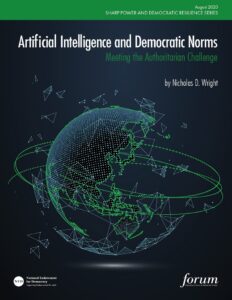 China is not foisting their model on an unwilling world, argues analyst Paul Scharre. Many countries are all too happy to emulate China’s example of how to suppress freedoms and tighten control over their population, which explains why Beijing’s arguments for illiberal governance have met a receptive audience in autocrats or autocratic-leaning leaders who have similar goals, he writes in his new book, Four Battlegrounds: Power in the Age of Artificial Intelligence, released today:
China is not foisting their model on an unwilling world, argues analyst Paul Scharre. Many countries are all too happy to emulate China’s example of how to suppress freedoms and tighten control over their population, which explains why Beijing’s arguments for illiberal governance have met a receptive audience in autocrats or autocratic-leaning leaders who have similar goals, he writes in his new book, Four Battlegrounds: Power in the Age of Artificial Intelligence, released today:
One of Beijing’s foreign policy goals is to secure Chinese Communist Party power by making “a world safe for autocracy,” according to Cornell professor Jessica Chen Weiss. This does not look like a Soviet-style campaign of fomenting communist revolutions around the world. Instead, on a variety of fronts, Beijing seeks to weaken existing institutions, laws, and norms of democracy and freedom. Weiss has written: “China’s actions abroad have . . . made the world safer for other authoritarian governments, and undermined liberal values. But those developments reflect less a grand strategic effort to undermine democracy and spread autocracy than the Chinese leadership’s desire to secure its position at home and abroad.”
 China’s export of surveillance technology – its “Command, Control, Communication, Cloud, Intelligence, Surveillance, and Reconnaissance [C4ISR]” solutions model – helps to normalize its own model of techno-authoritarianism, Scharre adds.
China’s export of surveillance technology – its “Command, Control, Communication, Cloud, Intelligence, Surveillance, and Reconnaissance [C4ISR]” solutions model – helps to normalize its own model of techno-authoritarianism, Scharre adds.
The global spread of AI surveillance technologies continues, including in many countries that lack the institutional mechanisms for checks and balances that exist in democracies, he concludes. The quicker that democracies can come together to develop a privacy-preserving model for how surveillance technology ought to be used, the sooner they can effectively push back against the growing wave of authoritarian uses of AI that threatens global freedoms. RTWT. HT: Breaking Defense.
Read @ZhangTaisu on Chinese President Xi Jinping’s efforts to create new sources of political legitimacy that do not rely on economic performance—and how a growing emphasis on the law could enhance the power of Beijing’s central authorities. https://t.co/XGF4RlUq79
— Foreign Affairs (@ForeignAffairs) February 27, 2023







